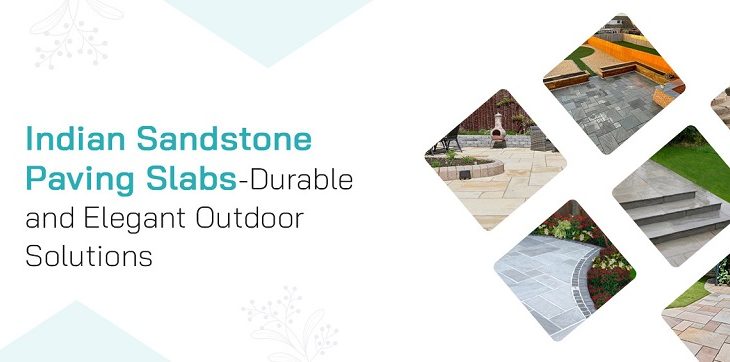Introduction
Creating a beautiful and long-lasting garden or patio space is a priority for many UK homeowners. Indian sandstone paving slabs offer an exceptional blend of natural beauty and robustness, making them a top choice for elegant outdoor solutions. This durable material not only elevates the look of your exterior but also performs brilliantly under the variable British climate.
Why Indian Sandstone Is Ideal for Your Outdoor Space
1. Timeless Appeal and Strength
Indian sandstone features a unique, warm colour palette, think soft beiges, gentle greys, and warm earth tones. This range of hues gives patio areas a refined, sophisticated feel. Its natural texture and subtle veining lend character to paths and seating areas without appearing too polished or artificial.
Apart from aesthetics, this stone is highly resilient. Its mineral composition makes it resistant to wear, and it handles freeze-thaw cycles, common in UK weather, far better than many other natural materials.
2. Versatility for Landscaping
One of the biggest advantages of Indian sandstone is its flexibility in use: it can be used for garden paths, patios, or even as cladding on low walls. You can easily pair it with garden tiles or mix it with Dijon limestone to bring together different stone finishes in your landscape. For a cohesive design, it also works beautifully alongside outdoor wall panels or as part of exterior wall cladding, giving harmony throughout the outdoor area.
3. Sustainable and Low-Maintenance
Indian sandstone is a natural and eco-friendly material when sourced responsibly. With minimal maintenance — sweeping, occasional cleaning, and resealing- the slabs retain their elegance. Sealing helps avoid algae growth and prevents staining, keeping your outdoor area looking pristine with minimal effort.
Installation Tips for Long-Lasting Results
1. Preparing the Base
To ensure longevity, it’s essential to lay paving slabs on a properly prepared foundation. A compacted, well-draining base prevents shifting and reduces the risk of cracks. Good jointing is equally important, as it minimises water ingress, which can cause damage over time.
2. Sealing for Protection
After installation, a breathable stone sealer acts as a barrier against dirt and moisture without trapping water inside. This helps maintain the stone’s natural appearance. Experts recommend resealing Indian sandstone every two to three years to preserve its finish and durability.
3. Cleaning Without Damage
- Routine Cleaning: Use a soft brush and a mild detergent with warm water for regular maintenance.
- Pressure Washing: It’s possible, but use a low-pressure setting and keep the nozzle at an angle and at a safe distance to avoid damaging the stone.
- Tackling Rust Marks: Occasionally, rust spots may appear due to the iron content in some sandstone. Use a stone-safe rust remover, testing it first on a small area.
- Winter Care: Avoid de-icing salts, as they can erode the stone. Instead, gently remove ice and keep an eye out for moss or algae growth.
The Key Benefits of Indian Sandstone Paving Slabs
- Elegance and Character: The natural stone finish adds a refined charm to any garden or patio, delivering exquisite outdoor solutions.
- Long-Lasting Durability: With correct installation and maintenance, sandstone paving can serve for decades.
- Cost-Effective Luxury: Compared to premium stones like granite, Indian sandstone offers a high-quality look without an exorbitant price.
- Low Maintenance Needs: Once sealed, the surface is easier to keep clean and resists growths like algae.
Considerations to Keep in Mind
- Porosity: Sandstone is naturally porous. Without sealing, it can absorb water and stains more easily.
- Quality Matters: Choose a reputable supplier to ensure the stone is of good thickness and structural integrity.
- Slip Risk: Polished or sawn finishes can be slippery when wet. For safety, riven or textured finishes are better for garden walkways.
Bringing It All Together: Durable Outdoor Solutions for Your Garden
Paving slabs deliver a harmonious mix of style, strength, and practicality. They fit seamlessly into layouts involving patio slabs, garden slabs, or slabs for garden paths. If you also want a cohesive look, these slabs can be combined with other elements like outdoor tiles, exterior wall cladding, or outdoor wall cladding.
Whether you’re renovating an outdoor patio or designing a new garden feature, Indian sandstone is a reliable choice that marries sophistication with long-term resilience.
Conclusion
By choosing Indian sandstone paving slabs, you’re investing in durable and elegant outdoor solutions that enhance the aesthetic and functional appeal of your exterior space. With the right installation and regular care, these slabs can transform your garden into a stylish, low-maintenance haven. Explore the range at Royale Stones to discover the perfect sandstone options for your project.
